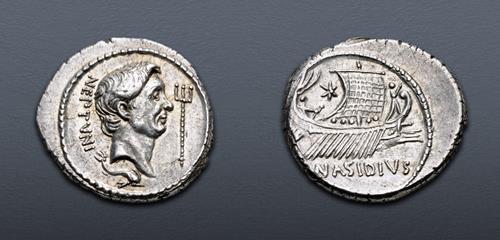
|
The Pompeians. Sextus Pompey. 42-38 BC. AR Denarius (18mm, 4.13 g, 5h). Massilia (Marseilles) mint; Q. Nasidius, commander of the fleet.
Triton XXV
Lot: 745. Estimated: $ 10 000
Roman Republican, Coin-in-Hand Video, Silver
Sold For $ 16 000. This amount does not include the buyer’s fee.
Go to Live
|
|
The Pompeians. Sextus Pompey. 42-38 BC. AR Denarius (18mm, 4.13 g, 5h). Massilia (Marseilles) mint; Q. Nasidius, commander of the fleet. Bare head of Pompey the Great right; trident to right; below, dolphin right; NEPTVNI to left / Galley with bank of rowers right, under full sail, helmsman steering rudder, hortator standing on prow; six-rayed star to upper left; [Q •] NASIDIVS below. Crawford 483/2; CRI 235; Sydenham 1350; RSC 20 (Pompey the Great); BMCRR Sicily 21; Kestner 3698; RBW 1698. Light iridescent toning, slightly off center on reverse. EF. Among the finest known for the issue, with an excellent portrait of Pompey.
Ex Numismatica Ars Classica 92 (23 May 2016), lot 401.
Sextus Pompey came of age during the ascendancy of his father, Gnaeus Pompeius Magnus (Pompey the Great), as the leading general of Rome and the most powerful man in the Republic. After Pompey’s defeat by Julius Caesar at Pharsalus in August of 48 BC, and his treacherous murder in Egypt later that year, Sextus joined the Pompeian resistance to Caesar in Spain. Caesar’s assassination on March 15, 44 BC brought a brief revival of Senatorial control, during which Sextus relocated to Massalia in southern Gaul. In April of 43 BC, the Senate appointed him commander of the Roman fleet. Although the promotion was rescinded three months later, Sextus wasted no time in seizing Sicily and spent the next months building an impregnable power base on the island even as Rome fell under the sway of Caesar’s political heirs, the Triumvirs Antony, Octavian and Lepidus.
This beautiful denarius belongs to the brief interval between Caesar’s murder and Sextus’ appointment as Praefect of the Fleet, during his sojourn at the Gallic port city of Massilia. The obverse portrait is clearly recognizable as Pompey the Great, although the legend identifies him as “son of Neptune” (an epithet won by Magnus after his defeat of the Cilician Pirates, and later claimed by Sextus himself) and provides him appropriate attributes— a dolphin and trident. The warship on the reverse appears to be a hemiola, a fast ramming vessel with two banks of oars totaling 52 a side. Interestingly, Sextus himself is not named; instead the moneyer is identified as Quintus Nasidius, a loyal Pompeian commander of naval forces who backed Sextus in his early career, only to later defect to Mark Antony.
The final winners of all Triton XXV lots will be determined at the live public sale that will be held on 11-12 January 2022. Triton XXV – Session Three – Roman Republican & Imperatorial Coinage through Byzantine Coinage will be held Wednesday morning, 12 January 2022 beginning at 9:00 AM ET.
Winning bids are subject to a 20% buyer's fee for bids placed on this website and 22.50% for all others.
We recognize that our users may have various Internet Browsers and Operating Systems. We like our visitors to have the best possible experience when using our bidding platform. However, we do recognize that it is impossible to develop applications that work identically, efficiently and effectively on all web browsers. The CNG bidding platform supports the latest stable major version and the stable previous version of Mozilla Firefox and Chrome.
|
